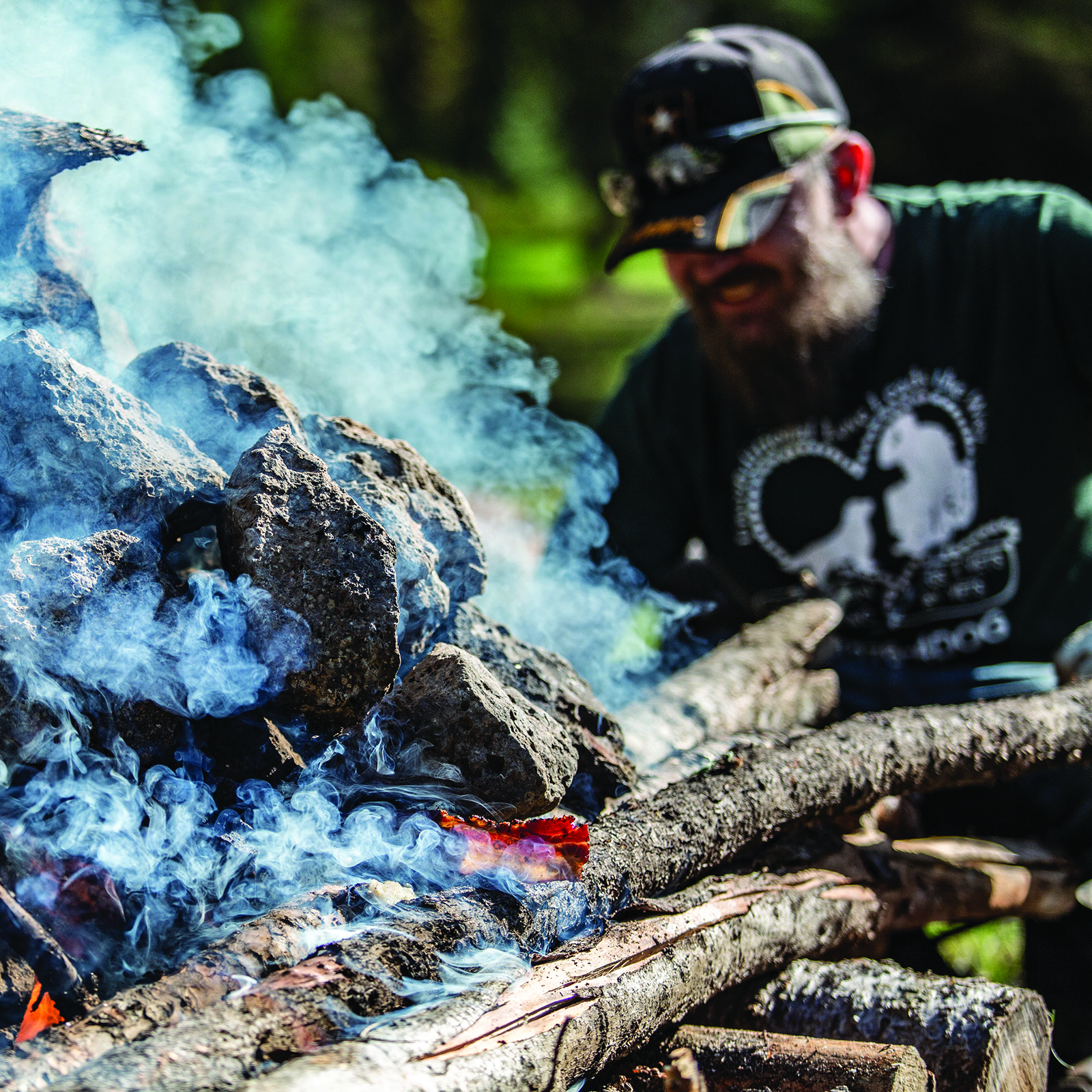
From the glowing embers of the hot lava rocks, the face of a young Vietnamese man emerged. The angry spirit charged at Blackfeet spiritual leader Roger Vielle. But Vielle was ready. He grabbed the spirit in his mind and threw it back into the rock pit, back into the spirit world where it belonged. After the sweat, a Vietnam War veteran explained he was the one who released the spirit. More than 40 years ago, he killed a young Vietnamese man with a bayonet. As he died, his eyes remained open. The face in the embers had haunted him every night since.
For the first time in four decades, the vet slept for eight uninterrupted hours.
The first time Vielle, 64, guided a sweat for combat veterans he had never felt the angry, abusive, guilt-ridden spirit that was PTSD. Ten years and more than a hundred sweats with vets later, he’s all too familiar with it.
On a sunny 80-degree May day, Vielle led nine veterans into a lodge built of willows, wool blankets and a hodgepodge of animal hides to steam at temperatures upwards of 200 degrees. The men, ranging in age from 39 to 73 with combat experience from Vietnam to Iraq, stripped down to their shorts, exposing tattoos, scars and invisible wounds in preparation for a cleansing with smoking sage. Vielle traced lines of smoke over the mens’ heads and shoulders with a wing from a golden eagle.
The sweat, held at Savenac Historic Tree Nursery in Haugan near the Idaho border, was organized by the Kalispell chapter of the Veterans Community Response (VCR), a non-profit organization of combat veterans who promote healing from the traumas of war through community service projects for fellow veterans and weekend retreats. In short, VCR is a community of vets helping vets.
Veterans from across Montana and parts of Idaho and Washington gathered in Haugan for a sober weekend filled with yoga, prayer circles, group therapy and sweating interspersed with games of cornhole, axe-throwing, a plethora of dirty jokes and the highest-quality food Costco has to offer.
The retreat was entirely funded by VCR and staffed by veteran volunteers. Brandon Spangler, a U.S. Marine Corps sergeant and licensed clinical social worker, founded the Kalispell chapter after recognizing a neglect in American culture to help vets reacclimate to civilian life after war. By contrast, sweat lodges were a non-negotiable part of many Native American warriors’ return from battle. Warriors built a four-teepee lodge, where they would fast and sweat until elders determined they had healed enough from the physical and spiritual wounds of war to reassimilate into society.
“It’s a beautiful thing the Natives have,” Spangler said. “All warriors are warriors.”
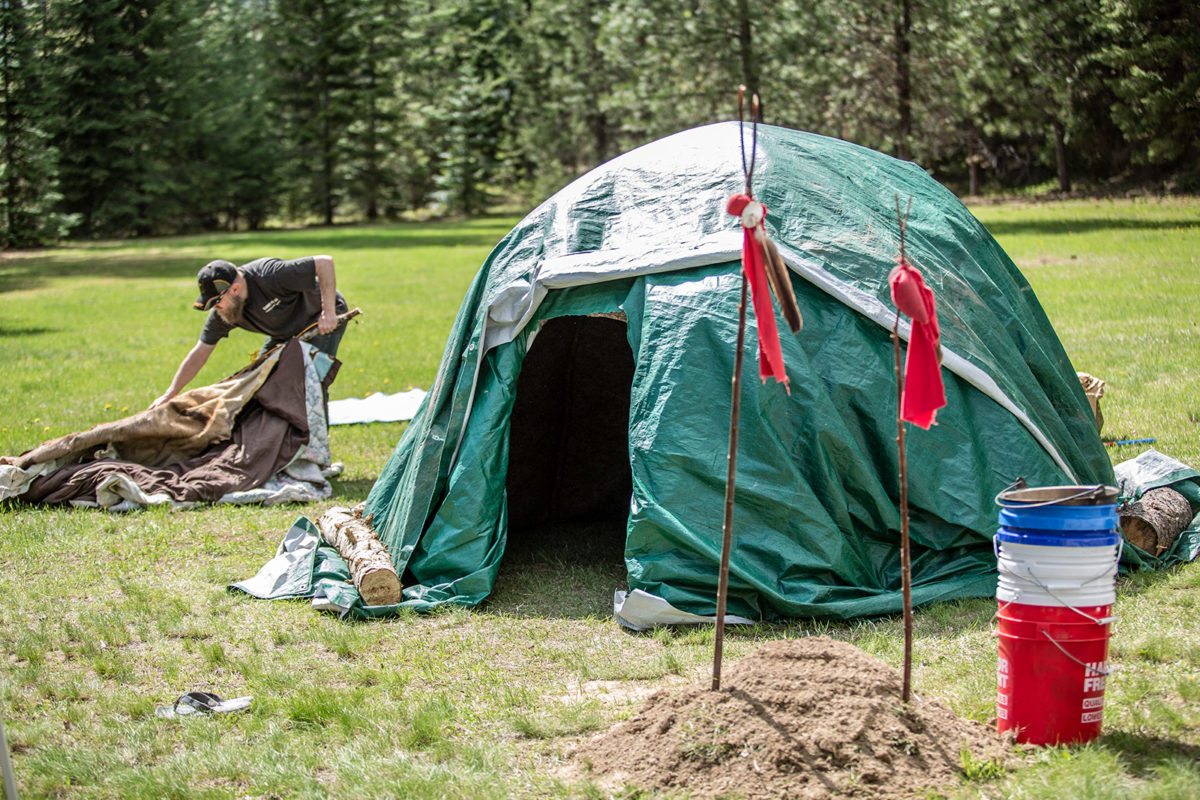
The first of the four sweat rounds honors children.
The thick hides drop over the sweat lodge entrance, engulfing the men in total darkness. The only point of reference is glowing embers from the lava rocks. When the embers fade, it’s easy to forget if one’s eyes are open or closed. Vielle pours a ladle of medicine water infused with sage, sweet grass and the medicinal root “kous kous” over the hot rocks. A suffocating wave of sweet, earthy steam rushes over the men’s faces, plunging down throats and up nostrils. Heart rates rise.
The dark, hot, moist chamber emulates the womb. “You’ve been there before, whether you remember it or not,” says 43-year-old Iraq War veteran Michael Carroll.
Carroll, a father of three children ages 1, 3 and 17, projects his own child-like sense of wonder and enthusiasm. Before sweats, however, he was a “horrible drunk.”
“It was exhausting being alive,” he said. “Sweats remapped everything. It reactivates cells that have been dormant for a long time.”
Carroll was one of hundreds of soldiers brought to the brink of death by heatstroke in Iraq in August of 2003. Wearing more than 30 pounds of gear and sitting in the driver’s seat of a running Bradley armored fighting vehicle, in temperatures above 130 degrees, Carroll’s internal organs began to cook.
After three days of lying immobile in a MASH (mobile army surgical hospital) unit in the Kuwait Desert, he awoke to meet the eyes of an Iraqi man with a wooden leg lying under the bed next to him. The man’s son, an 8-year-old whose leg had been injured in a building explosion, was in the bed above. If the boy’s leg had to be amputated, he would be the fourth male in their family to inherit the wooden leg. The boy kept his leg.
“The sweat blesses those outside of the sweat,” Carroll reminds his fellow veterans.
In life after service, Carroll has made volunteerism a career, dedicating time to no fewer than seven non-profit veteran organizations. Vets ill-equipped to navigate civilian life can “feel like an amputated limb,” he says. “If I have a small impact on someone, that’s a huge payment for me.”
For the last six years, Carroll has apprenticed under Vielle, learning how to facilitate sweats. As fire chief, it is his job to heat the lava rocks using the proper herbs, prayers and offerings. He ignites the teepee of dry wood stacked around the rocks using what Vielle calls an O.I.T. (old Indian trick) — he blasts them with a propane blow torch.
The rocks take several hours to heat. Once the other men enter the sweat, Carroll extracts one hot rock at a time with a pitchfork and lugs it into the lodge. For each rock, he says a one-word prayer: Love. Brotherhood. Grace. Perseverance. Peace.
“Some sweats are harder than others,” Carroll says, perspiration beading on his forehead as he stirs the fire. “It’s a form of healing through suffering. Sometimes you get something more powerful than you expected. It’s strong enough to make an atheist believe in something stronger than themselves.”
“Owipate!” comes a cry from inside the lodge. Open it.
Carroll flings the hide door open and the men come crawling out. Carroll helps one of the older vets to his feet.
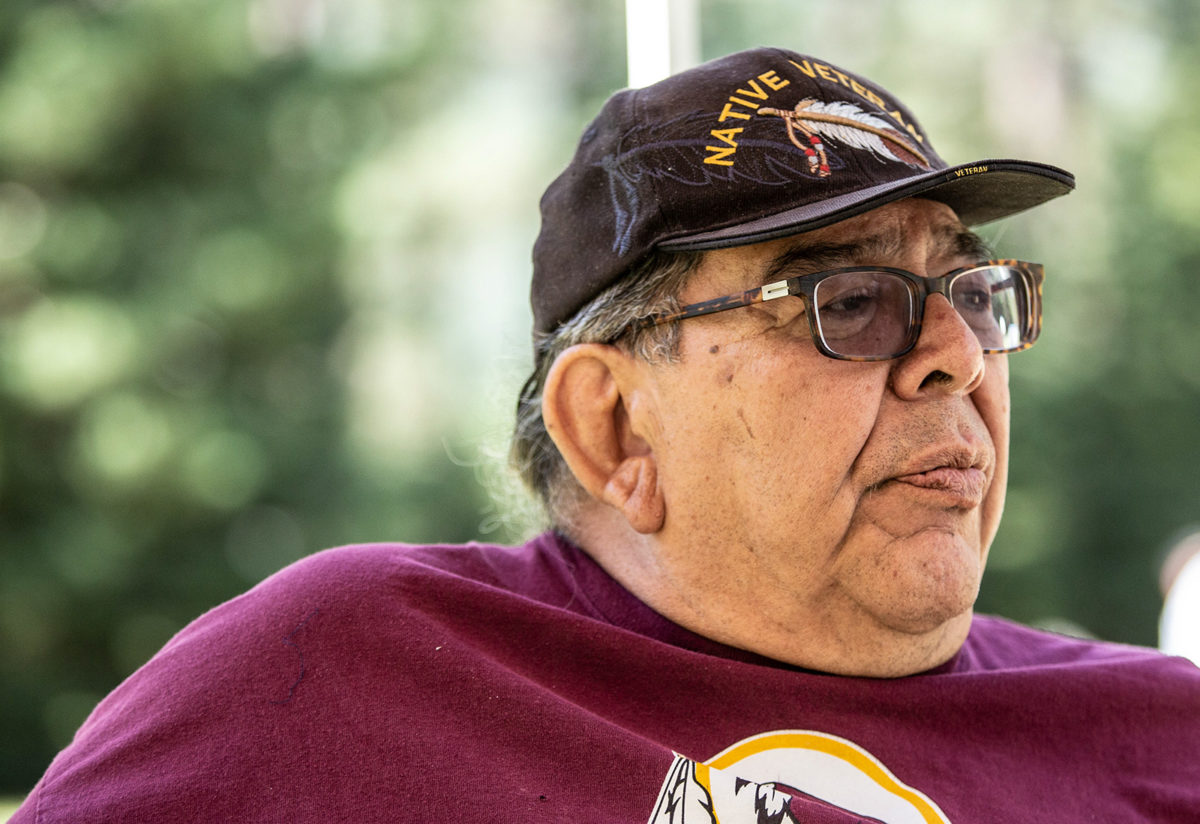
The second round honors women.
Within moments of the door closing, sweat cascades down faces like spring runoff, finding any available channel: tracing eyebrows, carving creeks around the creases of noses and falling in waterfalls from chins.
When Vielle sits down wrong and his hip replacement threatens to pop out of place, Henry Daychild, 43, steps up to lead the sweat without hesitation. A member of the Chippewa Cree Tribe from the Rocky Boy Reservation, Daychild has sweated since he was 6 years old. Sometimes as a child he sought sweat lodges on winter nights when he had nowhere else to sleep, knowing they would still be warm. “The rocks took care of me, ‘’ he said.
This is his first sweat with the VCR and the first he’s led, but he knows the songs and the ancestors guide his prayers.
Many of the men pray to their wives or sisters. Daychild has never seen the face or known the name of the woman who occupies his thoughts and prayers. Daychild was a passenger in a convoy in Iraq when the driver unintentionally ran over two children who got in the way. The driver went into shock as gunshots descended upon them. He still hears the screams of the children’s mother every day and every night.
His advice to new sweaters: “Release all that pain and trauma. Don’t be afraid to cry out.”
“Owipate!” The flap opens.
Between sweat rounds, Vielle shares stories in his deep, lilting voice. Some are beautiful tales of spiritual realms explaining how the sacred practices of his people came to be. Others are 10-minute setups for bad puns.
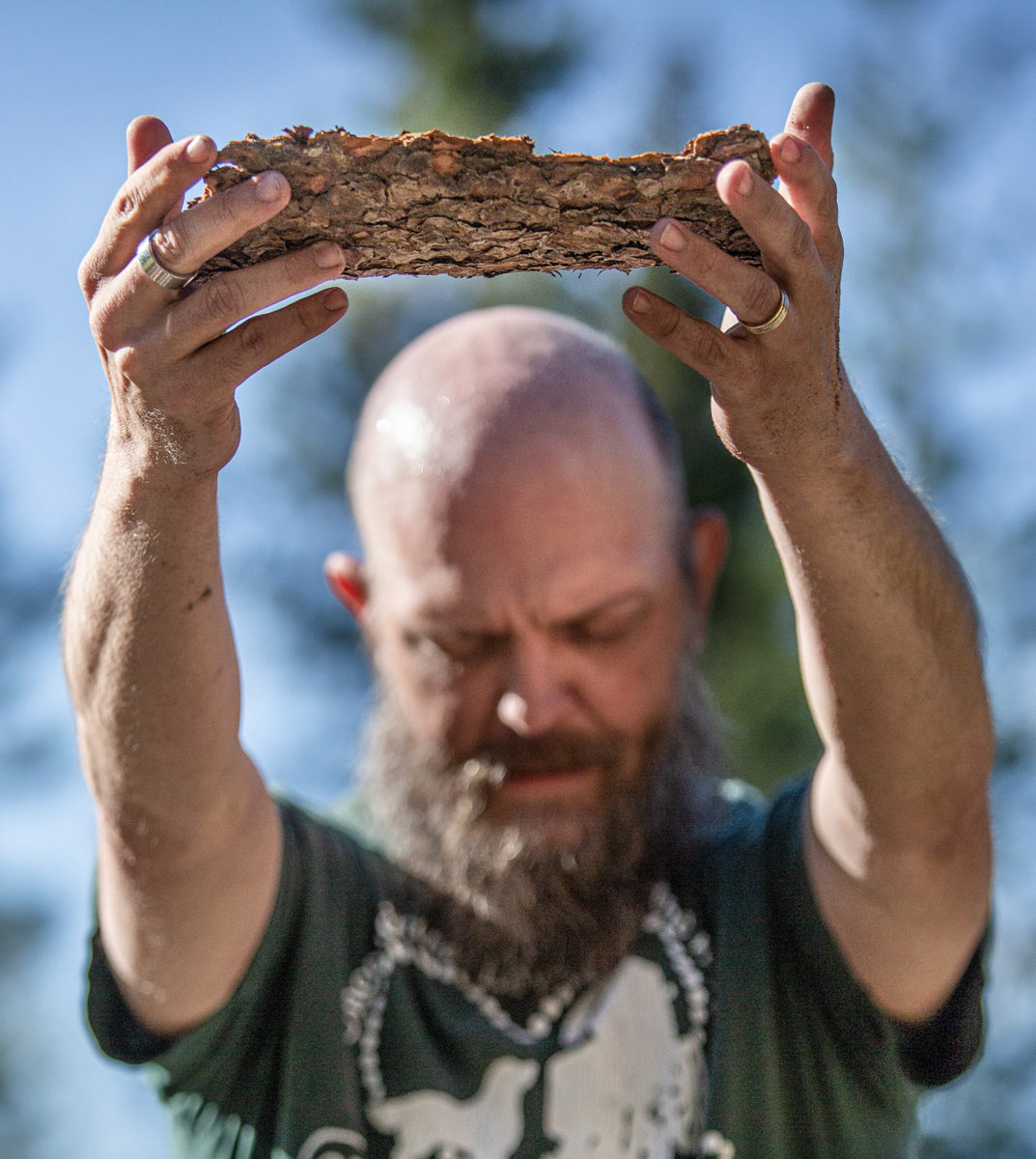
The third round honors all living things.
When the singing starts to fill the tiny cavernous space, the men are already wrapped in a blanket of steam. The heat is at once stifling and calming, like a hug. The beating of the hide drum reverberates through rib cages, and the hissing shake of gourds, meant to attract ancestors, fill ears and minds. Vielle explains that all living things include rocks, grass and trees as well as animals. The rocks are the oldest living thing; they represent the grandfathers.
Vielle, who grew up in Browning, has always driven to the major checkpoints in his life. The first came in the mid 1970s when, following six months of military service, including four in combat in Vietnam, he was transferred to Germany as a general’s personal driver and bodyguard. His job was to stay 15 feet away from the general at all times and start the car each morning, in case it blew up.
A decade later, when Vielle was in his late 20s, he got a job as Glacier National Park’s first Native American jammer bus driver. He told tourists “old Indian stories” and tolerated their naive questions jestingly, earning him the tour guide of the season award his first year. “It was the best summer job I ever had,” he said.
It wasn’t until 2010 that Vielle came to the VCR as a driver when sweats were held in East Glacier. After a bad experience with a non-veteran spiritual leader, the club asked Vielle to guide future sweats. It’s an honor he embraces proudly, but not without personal cost. “As a facilitator, we take on all the spirits. You have to know what you’re doing or you can get hurt,” he says. “Spirits can follow you out, plus others spirits. I have to have my own cleansing sweat after I go home, by myself.”
Yet Vielle returns every year. He shares the story of how sweat lodges came to be through the Morning Star — the first star to shine in the night sky after sunset. The moral: You have to heal from the inside first.
“Everyone has a different way of building the lodge,” Vielle explains, “but the purpose is all the same. To heal. To overcome. To become a better person. That’s why I do this.”
“Owipite!”
Vielle slowly crawls out several minutes after the other men have exited. With a smoldering glance, the portly 6-foot-3 man strikes a pose and twirls his bandana around like a pin-up girl. “You can put this on the cover,” he says.
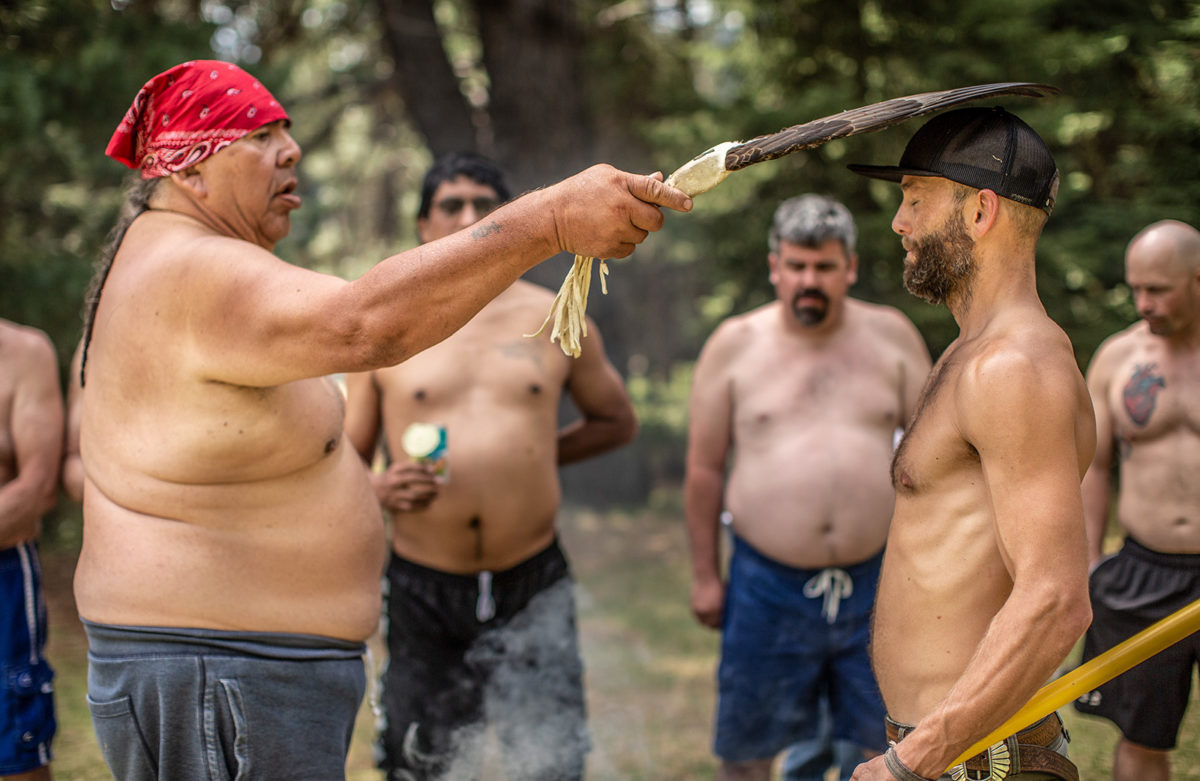
The fourth round honors the warriors.
By the hottest round of the sweat, pores and minds are wide open.
“You’ve got to go into it with an open mind,” says 73-year-old Vietnam War veteran Steve Malone. “I thought it was going to cure my cancer, but sometimes that doesn’t happen.”
In the late 60s, the U.S. military dumped millions of gallons of the powerful herbicide known as Agent Orange over forests and crops in Vietnam with the goal of wiping out enemy forces’ food supplies. The chemical was later linked to a high rate of birth defects, miscarriages, cancers and neurological problems not only in the Vietnamese people but also in the American soldiers who came in contact with it. Malone has lost three friends to Parkinson’s and cancer from Agent Orange exposure. After surgery, Malone’s prostate and leg cancer is in remission.
Malone was earning a college degree in child psychology when he was drafted into the 1st Battalion, 9th Marines. The elite unit was locked in battle for 47 months and seven days. Nearly 26% of the 2,892 Marines who passed through the battalion died in combat, earning them the nickname “The Walking Dead.”
“In the Marines, when you get two purple hearts on the same day, it only counts as one,” Malone said.
Malone’s first injury, a shot to the calf, was “only a flesh wound.” Later that day, his wrist was sliced open by a mortar and he almost bled to death. It wasn’t until his third injury sometime later when a 122 mm rocket blew him 10 feet into the air that he was sent home. “I woke up with 350 stitches in my arm.”
After two days at Camp Pendleton, Malone was “turned loose” into civilian life.
“When I came back, there was nothing,” he said. “I was lost. I didn’t know I had PTSD until 20 years ago. The VA was very slow at recognizing problems, like why vets were drinking and isolating.” Malone used alcohol and 16-hour workdays to avoid thinking about what he had encountered in combat. “The nightmares are like in 4K. I would wake up soaking wet and think, ‘I’m not drinking enough.’”
“Owipite!”
Now completely drug free, Malone exits his eighth sweat standing straight and tall. He looks like a young man ready to embrace new adventures rather than the oldest veteran at the ceremony.
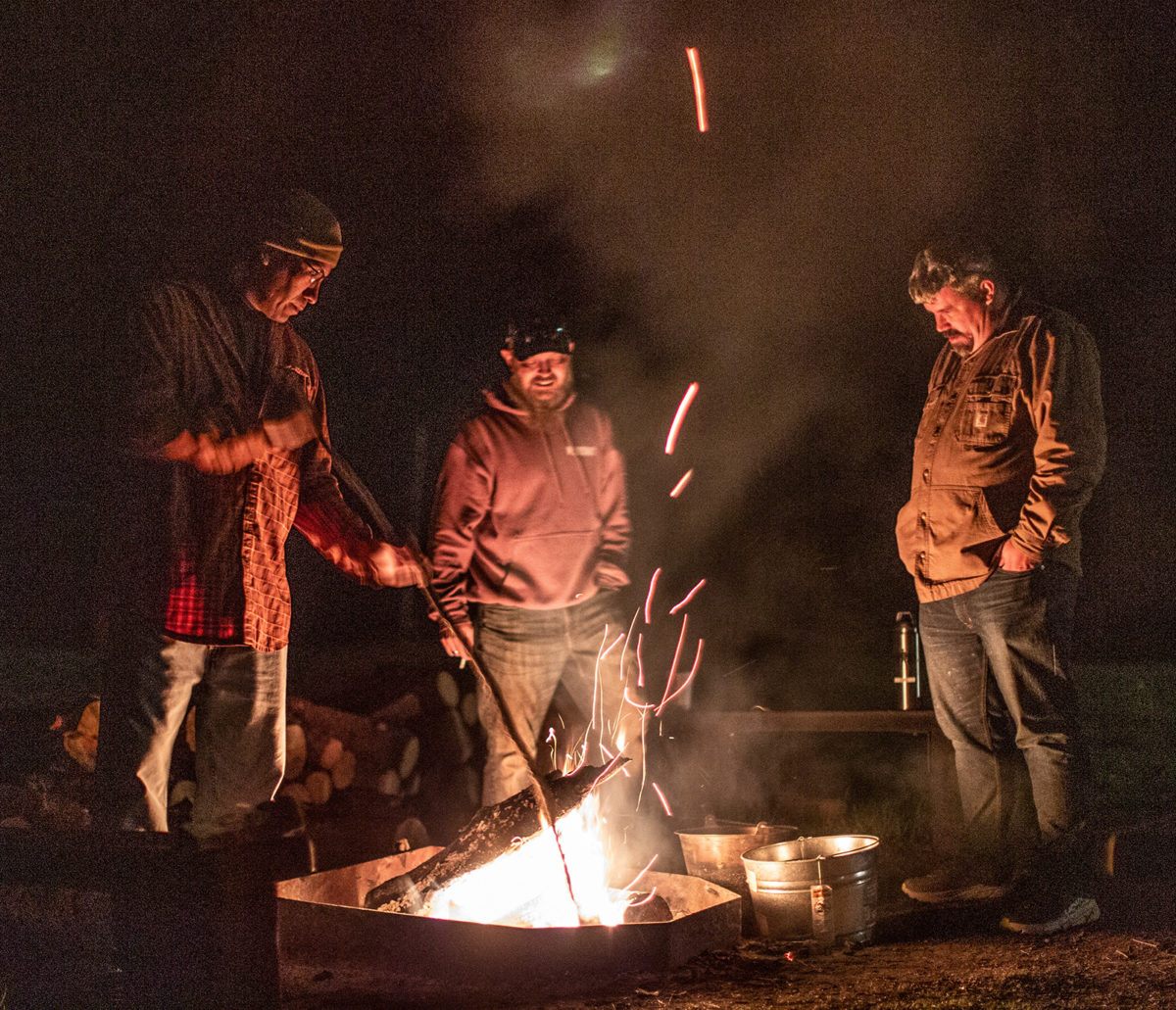
The optional final round is called the buffalo round.
Vielle doesn’t explain why it’s called the buffalo round, but he instructs the sweaters to stay for a moment longer. With a prayer, he dumps the remaining water from the bucket onto the hot rocks. Even the most experienced men burst out of the lodge to escape the thick, near-scalding cloud of steam.
Vielle chuckles as he says, “the buffalo chased you out!”
After a dinner of perfectly cooked New York strip steaks, the men circle the campfire. Spangler leads a discussion, prompting the warriors to share their healing journey. The veterans talk about freedom from anger, from addiction, from some of the nightmares that haunted them in their sleep. They share stories of connectivity — healing through volunteering, yoga, counseling, family and brotherhood.
“Every single one of us who has participated has branched out,” Carroll says. “We went from sitting in a room being pissed about everything to connecting with our community.”
Spangler looks forward to a future of diversified community involvement for VCR: a cleanup of Marias Pass in July, an all-women’s retreat in August and continuing the construction of their own retreat camp on donated land near Marion.
“(VCR) shows people they still have a community, they still have cohesion, they still have brothers and sisters. They still have a mission,” says Carroll. “That right there saves lives.”
For more information, Brandon Spangler can be reached at (509) 386-7855 or [email protected] or visit vetcomres.org.
Jessie Mazur is a writer, photographer and owner of Picture Montana. Raised in Whitefish, she now lives in Marion with her 3-year-old daughter and their dog. Her work can be found at www.picturemt.com.